It’s Saturday night in the city that never sleeps, and a frazzled Lorne Michaels (Gabriel LaBelle) is trying to maintain his cool in the 90 minutes before the premiere of his magnum opus, a risque and revolutionary live television show. A head shorter than every musical guest, comedian and NBC executive, Michaels is faced with an angry censorship representative, wildly ballooning expenses, a show that is almost two hours too long and grumpy comedian Jim Belushi who refuses to sign his contract.
Saturday Night is a mythologized and loose retelling of the iconic cultural moment that is the first airing of Saturday Night Live, the NBC sketch comedy show now in its fiftieth season. The characters are real writers and cast from those early seasons, including Cory Michael Smith as Chevy Chase and Matt Wood as Jim Belushi. But the main point of tension, that David Tebet (Willem Dafoe) would switch to a Johnny Carson rerun tape instead, is mostly fiction.
Just like how Michaels says his show is meant to encapsulate the feeling of being alive in New York City, the film – while not totally accurate – aims to encapsulate the chaotic and unpredictable nature of the earliest seasons of SNL. In the movie, several legendary stories from 30 Rock appeared in the 90 minutes before the show’s premiere, while in reality iconic scenes like Belushi ice skating in a bee costume occurred years later. Michaels did in fact meet legendary comedy writer Alan Zwiebel (Josh Brener) at a bar, but it was not in fact 20 minutes before the premiere began.
The movie is not meant to be a hyper-realistic documentary about the first time SNL aired. Rather, it is a depiction of the chaotic and unprecedented nature of this new style of live television and how it came about.
The screen intermittently cuts to a time card ticking away the minutes until 11:30, when the show is supposed to start. While this is meant to add to the tension of time quickly slipping away, it doesn’t fulfill this effect. While ninety minutes is not a lot of time to pull together a live television show, it is a decent amount of time to sit in a theater and watch. This aspect could be cut, and the time pressure would still be felt through the nonstop dialogue and constant flow of problems.
In a bit of awkward exposition that is out-of-place amidst the jumble of conversations and barrage of problems on set, writer Rosie Shuster (Rachel Sennott) details the nature of her relationship with husband Michaels to her boyfriend, Dan Aykroyd (Dylan O’Brien). This is one of the more accurate aspects of the film, as it was widely known at the time that Shuster was both married to Michaels and openly dating Aykroyd. It humanizes Michaels, who is a constant flurry of stress, and part of the iconic web of SNL stories, but its integration was clunky.
There is so much going on in this movie that it would be impossible to recount it all. There’s almost too much, but that’s part of its charm. The film exemplifies the excitement and chaos by being exciting and chaotic, leaving the audience energized and inspired to take a trip to the Big Apple.









